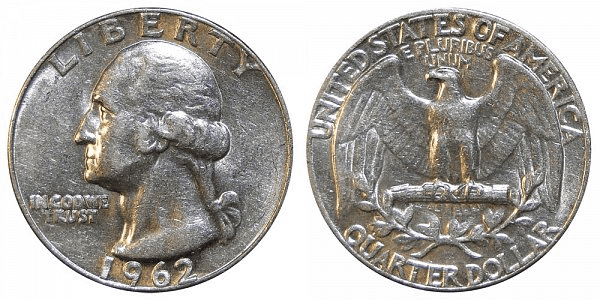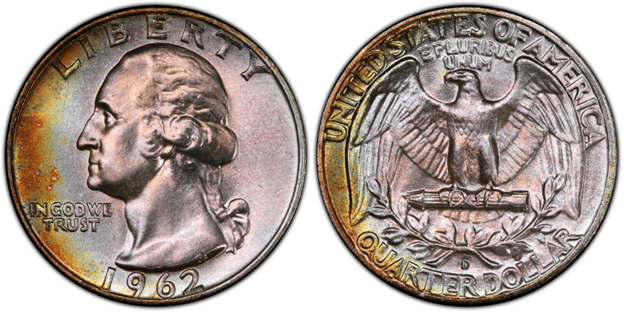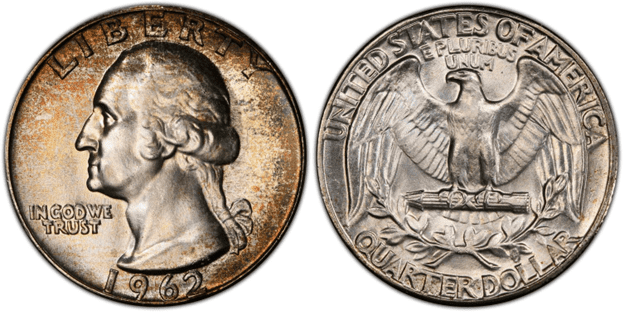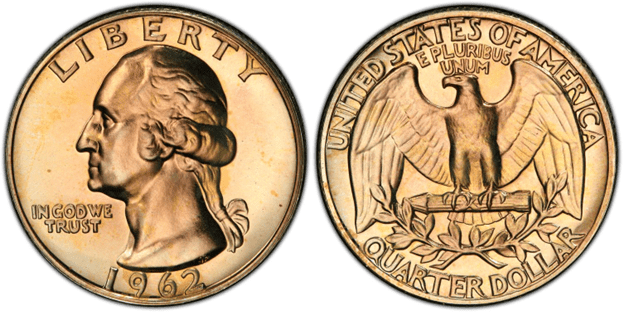What Is the 1962 Washington Quarter Made Of?
The 1962 Washington quarter is made of 90% silver (Ag) and 10% copper (Cu). Because it is made of silver, it is somewhat more expensive than other coins made with base metals.
The Washington quarter was first struck in 1932. The design and specifications essentially remained the same in 1962. Here are the specifications of the 1962 Washington quarter:
- Value – $0.25
- Mass – 6.30 grams
- Diameter – 24.30 mm
- Thickness – 1.75 mm
- Reeded edge (119 reeds)
The Washington quarter would later be turned to cupro-nickel composition starting in 1965. Silver was getting more expensive by this time. Thus, the US Mint decided to remove it from the Washington quarter. Nevertheless, since 1976, the US Mint still produced special silver Washington quarters intended for collectors.
As mentioned, the quarter began to have George Washington’s face in 1932, which is also the bicentennial year of his birth. It’s one way for the United States to honor its first president.

John Flanagan designed the original version of the Washington quarter. He was an American sculptor who was known for his plaquettes and statuary. Later, he was known more for his coin and commemorative medal designs.
When it comes to design, the 1962 quarter’s obverse features the image of Washington, facing to the left. The inscriptions include the following:
- LIBERTY
- IN GOD WE TRUST
- 1962
- Mint mark (if present)
On the reverse side, there’s the heraldic eagle holding on its talon a bundle of arrows. Below the eagle are olive branches. The inscriptions include the following:
- UNITED STATES OF AMERICA
- E PLURIBUS UNUM (US motto, which means “Out of many, one.”)
- QUARTER DOLLAR
1962 Washington Quarter Varieties
For the 1962 Washington quarter, there are three standard-struck varieties produced. These are the 1962 D, 1962 P with no mint mark, the 1962 P proof, and the Washington Quarter.
Aside from that, there are also those coins with errors that created a new variety.
1962 D Washington Quarter
Year of minting: 1962
Mint Mark: D
Place of minting: Denver
Quantity produced: 127,554,756
Face Value: $0.25 (twenty-five cent)
Price: $7 to $15 (or more)
Mass: 6.30 grams
Edge: Reeded
Designer: John Flanagan
Composition: 90% silver and 10% copper
Diameter: 24.3 millimeters
Thickness: 1.75 millimeters

The 1962 D Washington quarter was struck in the Denver Mint. It is the most abundant variety of the 1962 Washington quarter coins with more than 127 million of them.
What’s interesting about this coin is that there were plenty of it issued in 1962. However, today, this is one of the Washington quarters that are scarce in gem condition. Most 1962 D quarters that have survived today have plenty of scratches.
The price starts at around $7 to $15. It can be higher depending on the condition of the coin.
1962 P Washington Quarter
Year of minting: 1962
Mint Mark: No mint mark
Place of minting: Philadelphia
Quantity produced: 36,156,000
Face Value: $0.25 (twenty-five cent)
Price: $7 to $16 (or more)
Mass: 6.30 grams
Edge: Reeded
Designer: John Flanagan
Composition: 90% silver and 10% copper
Diameter: 24.3 millimeters
Thickness: 1.75 millimeters

The 1962-P quarter coin was made in the Philadelphia Mint. At the end of 1962, there were 36,156,000 P Washington quarter coins produced, which was far less than what the Denver Mint produced. Nevertheless, there are more 1962 P quarters today that are in Gem condition than the 1962 D. You can sell this coin for $7 to $16.
1962 P Proof Washington Quarter
Year of minting: 1962
Mint Mark: No mint mark
Place of minting: Philadelphia
Quantity produced: 3,218,019
Face Value: $0.25 (twenty-five cent)
Price: $8 to $36 (or more)
Mass: 6.30 grams
Edge: Reeded
Designer: John Flanagan
Composition: 90% silver and 10% copper
Diameter: 24.3 millimeters
Thickness: 1.75 millimeters

The Philadelphia Mint also produced quarter proof coins in 1962. There were about 3.2 million of them. As you may have noticed, the production is too low compared to other types of 1962 quarters. The reason is that proof coins are not meant for circulation. They are made for collectors.
Proof coins are more detailed, shinier, and more attractive compared to regular-struck coins. Proof coins are even struck twice to really bring out a greater detail on their surface. The average price may range from $8 to $36.
List of 1962 Washington Quarter Errors
With almost 167 million 1962 Washington quarter coins produced, it is not surprising to see that some of these coins had inevitably received an error. Minting errors do happen sporadically and when they do, it can be because of a number of reasons.
For example, the error may originate from the cutting of the planchet. It can be that the coin wasn’t perfectly shaped. It could be too thin or thick. Some planchets are clipped or folded.
Planchets may also have a lamination error. During the melting of the planchet, some impurities got into the silver and copper mixture. Thus, when it cooled down, the coin separated or cracked.
The die can also break due to repeated strikes. When the die cracks, the crack is also engraved on the coin. That’s why you see error coins with unusual lines.
Usually, the die only strikes the planchet once. However, the die may unintentionally strike the planchet twice leading to an error called double die obverse (DDO) and double die reverse (DDR). The more pronounced and obvious the double die error, the more valuable the coin is.
Aside from that, dies may not be able to hit the planchet at the right angle leading to off-center strike errors. Sometimes, strikes can be weak and the engraved elements are too soft. Plus, the die may strike through a foreign material, which can cause some additional engraved elements.
While it is true that the US Mint doesn’t want to have any errors when minting, a lot of coin enthusiasts are super interested in error coins. After all, error coins give rise to unique and rare coins and they are fun to collect.
How Much Is the 1962 Washington Quarter Worth Today?
The 1962 Washington quarter has a face value of $0.25. However, since it’s made of silver, the melt value is higher at $3.9226. Moreover, you can expect that there are 1962 Washington quarters that are way valuable.
Here’s a 1962 Washington Quarter values chart to help you know more about how much these quarters are:
| Coin | Condition | Grade | Mintage | Value |
| 1962 D Washington Quarter | Circulated/mint | Not graded | 127,554,756 | $7 to $15 |
| 1962 D Washington Quarter | Uncirculated/mint | MS-65 | 127,554,756 | $14 to $32 |
| 1962 D Washington Quarter | Uncirculated/mint | MS-66 | 127,554,756 | $49 to $630 |
| 1962 D Washington Quarter | Uncirculated/mint | MS-67 | 127,554,756 | $660 to $3,120 |
| 1962 P Washington Quarter | Circulated/mint | Not graded | 36,156,000 | $7 to $16 |
| 1962 P Washington Quarter | Uncirculated/mint | MS-65 | 36,156,000 | $25 to $352 |
| 1962 P Washington Quarter | Uncirculated/mint | MS-66 | 36,156,000 | $35 to $456 |
| 1962 P Washington Quarter | Uncirculated/mint | MS-67 | 36,156,000 | $840 to $5,040 |
| 1962 P Proof Washington Quarter | Uncirculated/mint | Not graded | 36,156,000 | $8 to $36 |
| 1962 P Proof Washington Quarter | Uncirculated/mint | MS-68 | 36,156,000 | $14 to $40 |
| 1962 P Proof Washington Quarter | Uncirculated/mint | MS-69 | 36,156,000 | $17 to $62 |
| 1962 P Proof Washington Quarter | Uncirculated/mint | MS-70 | 36,156,000 | $176 to $322 |
As you can see, the 1962 Washington quarters could still be sold for a higher price.
Just to give you an idea, according to the records of the PCGS, a 1962 quarter with a grade of MS 67 was sold for $26,400 on March 16, 2019. For the 1962 D, the auction record is $18,400. Finally, for the 1962 P proof quarter coin, the auction record is $322.
How Does The Grading System Work?
The Sheldon Scale is used by numismatists to provide a numerical value to coins. The Sheldon Scale goes from poor (P-1) to perfect mint state (P-1) (MS-70). Coins were originally evaluated using words to reflect their condition (Good, Fair, Excellent, Etc.). Unfortunately, coin collectors and dealers had different ideas about what each of these terms represent.
Professional numismatists joined together in the 1970s and established CoinGrading standards. These numismatists now assign grades at key places on the seventy-point scale, using the most regularly utilized numeric points in conjunction with the original adjective grade. The following are the most common coin grades:
-
-
- (P-1) Poor – Indistinguishable and probably damaged; if used, must have a date and mintmark; otherwise, rather battered.
- (FR-2) Fair – Nearly smooth, but without the damage that a coin graded Poor often possesses. The coin must have enough detail to be identified.
- (G-4) Fair – Inscriptions have merged into the rims in some areas, and important elements have been mostly erased.
- (VG-8) Very Good- A little weathered, but all of the primary design elements are visible, albeit faintly. There is little if any, central detail left.
- (F-12) Good – The item is very worn, yet the wear is even, and the overall design details stand out clearly. Rims are almost completely isolated from the field.
- (VF-20) Very Fine – Moderately weathered, with some finer features still visible. The motto or all letters of LIBERTY are readable. Both sides of the coin have entire rims that are separated from the field.
- (EF-40) Extremely Fine – Gently used; all gadgets are visible, and the most important ones are bold. The finer details are bold and clear, however, light wear may be seen.
- (AU-50) Uncirculated – Slight evidence of wear on the coin’s design’s high points; may have contact marks; eye appeal should be adequate.
- (AU-58) Uncirculated Choice – Slight traces of wear, no severe contact marks, almost full mint shine, and great eye appeal.
- (MS-60) Mint State Basal – Strictly uncirculated; no indication of wear on the coin’s highest points, but an unsightly coin with reduced luster, visible contact marks, hairlines, and other flaws.
- (MS-63) Mint State Acceptable – Uncirculated, but with contact scratches and nicks, little reduced shine, but otherwise appealing appearance. The strike is weak to average.
- (MS-65) Mint State Choice – Uncirculated with great mint shine, very little contact blemishes, and exceptional eye appeal. The strike is unusually severe.
- (MS-68) Mint State Premium Quality – Uncirculated with superb luster, no obvious contact marks to the naked eye, and exceptional eye appeal. The strike is quick and appealing.
- (MS-69) Almost Perfect Mint State – Uncirculated with perfect brilliance, a sharp and appealing strike, and extremely good eye appeal. A near-perfect coin with minor imperfections in the planchet, strike, and contact markings (seen only under 8x magnification).
- (MS-70) Mint State Perfect – Under 8x magnification, there are no tiny imperfections discernible; the strike is crisp, and the coin is perfectly centered on a beautiful planchet. Rarely seen on a coin, this coin is bright and whole, with original luster and exceptional eye appeal.
-
Where To Buy Or Sell 1962 Washington Quarter?
The 1962 Washington quarters are available online and in physical stores.
For online stores, you can head to Amazon and eBay, two of the most popular online marketplaces today. You can also use social media such as Facebook, Twitter, and Instagram to find people who might want to sell you their coins or buy your coins.
Aside from the Internet, you can join auctions. Some of the rarest and most expensive coins were sold in an auction.
You can also visit coin shops, pawnshops, and antique stores. They can buy your coin or find something from their inventory that you want to buy.
If you wish, joining clubs and groups of coin collectors could be a good idea. They may have an extensive network of people who buy and sell 1962 Washington quarters.
FAQs
Is a 1962 quarter all silver?
The 1962 quarter is not all silver but almost silver. It is made of 90% silver and 10% copper.
What is in the 1962 Type B Reverse Quarter?
The 1962 type B reverse quarter is a type of Washington quarter that has a regular-struck obverse but proof-struck reverse. This means that the obverse was struck with a regular die while the reverse was struck with a proof die. The reverse is shinier, more attractive, and more detailed. The 1962 type B reverse quarter is extremely rare.
How do I know if my 1962 D Washington Quarter has errors?
You can compare your 1962 D Washington quarter with other regular coins. Identify any difference. Most of the time, errors should be easy to identify with just one glance. You can look at the overall appearance of the coin.
If you have a magnifying glass, you can use that to closely examine each engraved element on the coin. If you believe your 1962 has an error, you can approach a qualified coin appraiser or numismatist to examine your coin. They should be able to confirm whether your coin has errors or not.
